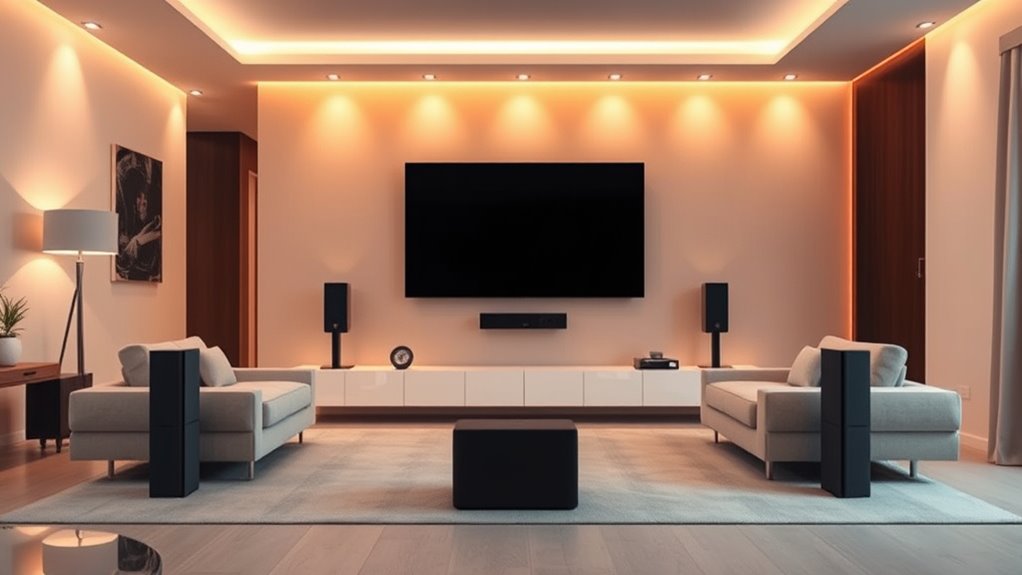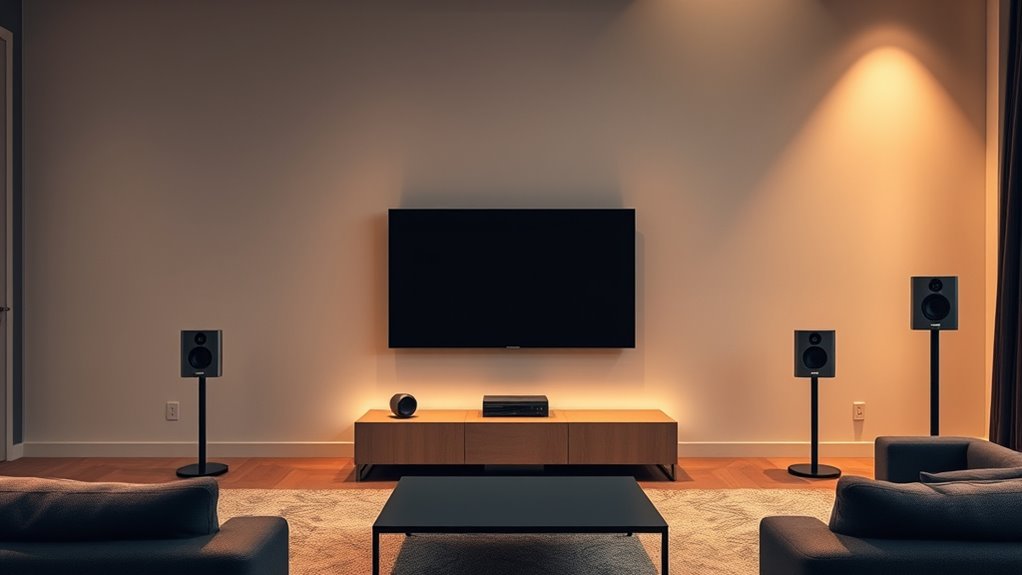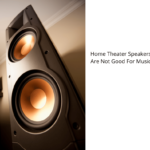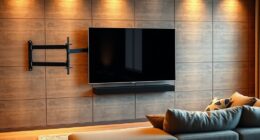Wireless surround sound systems have become quite reliable and easy to set up, making them a practical choice for many. While they’ve improved in sound quality and stability, you might still notice slight differences compared to wired setups, especially in high-end systems. Interference and network issues can occasionally cause glitches, but overall, they’re more ready than ever for everyday use. If you explore further, you’ll discover tips to maximize their performance and reliability.
Key Takeaways
- Wireless surround systems are increasingly reliable but still may face interference and latency issues compared to wired setups.
- Advances in wireless audio tech have significantly improved sound quality, narrowing the gap with wired systems.
- Setup is quicker and more straightforward, ideal for clutter-free, casual home theaters and modern interiors.
- Higher cost reflects technology complexity and convenience, making them suitable for general use but less ideal for audiophiles.
- Ongoing improvements suggest wireless systems are becoming a practical, ready alternative for most consumers, though perfect performance is still evolving.

Have you ever wanted a theater-quality sound experience without the clutter of wires? Wireless surround sound systems promise just that — clean setups, fewer tripping hazards, and the freedom to place speakers wherever you want without worrying about tangled cables. As technology advances, more brands are offering these systems, claiming they deliver immersive audio comparable to traditional wired setups. But before you ditch the wires entirely, it’s worth considering whether these systems are truly ready for prime time.
The first thing you should know is that wireless doesn’t always mean completely cable-free. Many systems still require power cords for the speakers and a stable connection to the main unit, which often connects to your TV or receiver via Wi-Fi or Bluetooth. The convenience lies in eliminating the long HDMI or speaker wire runs, making setup much cleaner and more flexible. However, the quality of the wireless connection can vary, and interference from other devices or Wi-Fi networks might cause audio dropouts or latency issues. If you’re in a busy household with lots of wireless activity, this could impact your listening experience.
Sound quality is another critical factor. Leading brands have made significant improvements, and many wireless systems now offer impressive clarity, deep bass, and a broad soundstage. Yet, they sometimes still fall short of top-tier wired systems, especially when it comes to delivering the kind of dynamic range and zero-latency performance that audiophiles crave. For casual viewing or gaming, the gap might be negligible, but if you want the absolute best sound, wired might still be preferable. Additionally, advances in wireless audio technology continue to narrow this gap, making these systems more competitive than ever.
Ease of installation is a major selling point. Wireless setups typically involve fewer steps, and many systems come with user-friendly apps to help you fine-tune sound settings. You don’t have to worry about running cables through walls or under carpets, which can be time-consuming and messy. But keep in mind that a reliable Wi-Fi network is essential; unstable connections can disrupt your experience. If your internet setup is spotty, you might need to upgrade your network or consider hybrid solutions that combine wired and wireless elements. Proper network setup can significantly improve overall performance.
Finally, consider the cost. Wireless surround sound systems tend to be more expensive upfront, partly because of the technology involved. While they save you time and effort in installation, you should weigh whether the convenience and aesthetic appeal justify the extra expense. Overall, wireless systems have come a long way and are increasingly reliable, but they still might not fully replace wired setups for audiophiles or home theater enthusiasts seeking perfection. For casual use and modern, clutter-free living spaces, though, they’re rapidly becoming a practical and attractive option.
Frequently Asked Questions
How Do Wireless Surround Sound Systems Compare in Price to Wired Setups?
When comparing prices, wireless surround sound systems usually cost more than wired setups. You might find wireless options with similar features, but they often come with a higher price tag due to the technology involved. Wired systems tend to be more budget-friendly and offer reliable sound quality without connectivity concerns. However, if you value convenience and cleaner setups, paying extra for wireless could be worth it for you.
What Are the Best Brands Currently Offering Reliable Wireless Surround Sound?
They say “you get what you pay for,” and that’s true with wireless surround sound brands. Currently, you should look at options like Sonos, Bose, and Yamaha for reliable performance. These brands have proven track records, offering seamless connectivity and solid sound quality. If you prioritize dependability and ease of use, investing in these trusted names guarantees you won’t be disappointed with your wireless setup.
Can Wireless Systems Be Integrated With Existing Home Automation Setups?
You can definitely integrate wireless surround sound systems with your existing home automation setup. Many modern systems support popular smart home platforms like Alexa, Google Home, or Apple HomeKit. You’ll want to guarantee compatibility before purchasing, but once connected, you can control your audio and automation features seamlessly through your preferred app or voice commands. This integration makes managing your home entertainment effortless and enhances your overall smart home experience.
What Are the Common Connectivity Issues With Wireless Surround Sound Systems?
When it comes to wireless surround sound systems, connectivity issues are common. You might experience dropouts, lag, or interference from other devices like Wi-Fi routers or cordless phones. These problems can disrupt your listening experience and often stem from weak signals or congested networks. To improve connectivity, verify your system has a strong, stable connection, update firmware regularly, and minimize interference from other wireless gadgets.
How Does Audio Quality in Wireless Systems Compare to Wired Alternatives?
You’ll find that wireless systems have improved, but they still can’t quite match wired options in audio quality. Wireless setups sometimes experience latency or compression, which can affect clarity and detail. However, high-end wireless systems now deliver impressive sound that’s often indistinguishable from wired ones for most users. If convenience outweighs perfect fidelity for you, modern wireless surround sound can be a great choice, though wired remains the gold standard for audiophiles.
Conclusion
Wireless surround sound systems are evolving, and the promise of seamless, clutter-free audio experiences is within reach. As technology advances, affordability increases, and compatibility expands, you can enjoy immersive sound without the wires. Embrace the convenience, revel in the clarity, and enjoy the freedom of wireless audio. Ultimately, whether you’re watching movies, gaming, or listening to music, wireless surround sound systems are becoming ready for prime time—are you ready to experience them?
Hello, I’m Art, and I’m excited to be a part of the 1Home Theatre Projector team. As a writer, I’m here to contribute my knowledge and insights to help you achieve the ultimate home cinema experience. I understand that making decisions in the world of home entertainment can be complex, and I’m here to simplify the process for you.
















